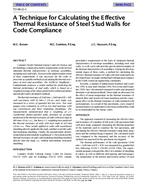Description
Canada's Model National Energy Codes for Houses and for Buildings contain prescriptive requirements in the form of minimum thermal characteristics of envelope assemblies, including steel stud walls. To assist in the uniform enforcement of these requirements, it was necessary for the codes to prescribe acceptable methods of calculating the thermal resistance of steel stud assemblies. The ASHRAE Handbook-Fundamentals proposes a simple method for predicting the thermal performance of stud walls, which is based on a weighted average of the values predicted by isothermal planes and parallel path calculation methods.
The thermal resistance of 2440 mm × 2440 mm (8 ft × 8 ft) wall specimens, with 92 mm (3 5/8 in.) steel studs, was measured in a series of guarded hot box tests. Two stud gauges were evaluated, as well as two stud spacings, with one wood-based and three insulating sheathings. The measurements demonstrated that a weighting of 2:1 (isothermal planes:parallel path) provided an accurate prediction of the thermal resistance of walls with steel studs at 406 mm (16 in.) o.c., but that a 1:1 weighting best predicted the thermal resistance of walls with steel studs at 610 mm (24 in.) o.c. These results applied to walls with wood-based sheathing directly applied to the studs, whether or not the walls had insulating sheathing. Finally, the measurements demonstrated that an intermediate weighting of 3:2 best predicted the thermal resistance of walls with insulating sheathing installed directly onto the studs, i.e., without intermediate structural sheathing.
Units: Dual
Citation: Symposium, ASHRAE Transactions, 1998, Vol. 104, Part 2, Toronto, ON
Product Details
- Published:
- 1998
- Number of Pages:
- 11
- File Size:
- 1 file , 200 KB
- Product Code(s):
- D-7765
